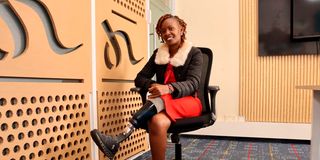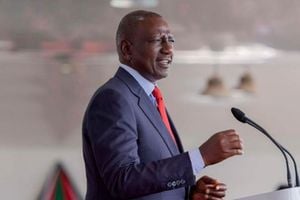Born with a missing limb

Magdalene Chesoli during the interview at Nation Centre, Nairobi on April 24
What you need to know:
- While I knew that I did not have a second leg, that was the least bothersome thing in my life at the time.
- It was in high school that it dawned on me that I was different and needed to conceal my identity.
“I was born with one functional leg and, growing up, not once did I think that I was different from other people. I went to a regular school and mingled with other children. While I knew that I did not have a second leg, that was the least bothersome thing in my life at the time. It was in high school that it dawned on me that I was different and needed to conceal my identity.
My kind of amputation is congenital –meaning that nothing really caused my loss of a limb. Like I said, I was born like that, but I still relate to the struggles of people who once had a leg and lost one for whatever reason.
All through my primary school, I used crutches to support my walking. Anyone who has used crutches can tell you how cumbersome it is. Most of my clothes could get torn around the armpit and the knee area.
I was surprised when my parents opted to take me to a special school in high school. While that should have made me feel like I belonged, it made my self-esteem crumble. I am naturally quite jumpy. I even participated in sporting activities in school, but given the chance to interact with other students during symposiums and outings, I would coil in my corner to feel at peace, but was I?
It was in high school that I got my first prosthetic (an artificial leg given to amputees). I remember my school principal called my mum and told her about the offer, which was from a well-wisher in Nairobi. Gladly, she agreed and together with three other classmates, we travelled from Kisumu to Nairobi to have our prosthetics fitted.
The transition was not easy. When you are adjusting to something new, mentally, you are never ready because I was used to my crutch.
The new ‘leg’ felt quite heavy and my friends and I contemplated doing away with it. Trying to make a step was quite challenging because we were advised not to hold on to anything.
It took us about three months to get used to the prosthetic, which had its challenges as well. I could not walk for more than a kilometre without getting a bruise –the friction was too much. Again, at the time, I had no option because even the prosthetic I had was a donation. I like to say that getting one is as expensive as buying a piece of land or a car, and not everyone can afford those. I remember my mum once had a sit down with me and told me that I had two options; to either go to school, or get an alternative prosthetic.
On campus, my esteem was still sub-par. My wardrobe had characteristic clothes — I would only wear trousers and long dresses and skirts. My roommates did not get a chance to see my leg, except one, whom I trusted to share that, and even let her touch my prosthetic.
I was not proud of myself at the time. At the back of my mind, I thought that people would discriminate against me or view me differently when they learned that I didn’t have both legs. Some people could stare because no matter how much I hid the leg, there was always some form of distinction, especially when I walked.
I learnt that people have assumptions, that’s why limb loss awareness needs to be highlighted. First, we have two types of amputees; below the knee and above the knee. Mine is below the knee. I have used two prosthetics so far and the one that I am currently using is a bit lighter and better in terms of functionality. The difference is that in my first, there was no technology involved, which is why I struggled to walk for longer distances.
It is through dancing, one which could pass as unconventional for amputees, that I got my new prosthetic. I was part of an awareness campaign dubbed — Express Your Beauty — organised by an organisation called Circleg, which is a startup that manufactures prosthetics. After my new prosthetics were fit, I danced my heart out, and my perspective about my body changed. I no longer feel ashamed to show the world my different legs. I even take part in other fun activities like zip lining and giant swinging.
While I may seem okay now with my new prosthetic, I remain compelled to tell stories of other amputees. This is why I started a podcast to let them share their struggles, most of which I relate to.
The government needs to do better for amputees.
I know that the National Council for Persons with Disabilities gives amputees prosthetics, but everyone I have interacted with who tried getting it from there says the process is quite long and frustrating. I wish the process could be made easier. I also realised that there is only one insurer that gives amputees an opportunity to use their service. Otherwise, everything is paid out-of-pocket.
People also assume that one prosthetic can be used for a lifetime, and that we have it on all the time. They are like shoes, worn only when need be, and people don’t even go to bed with them. The prosthetic also needs to be occasionally cleaned. We know how expensive maintaining it can be, or even acquiring one, which is why we need a change of some policies, especially from insurance providers who need to include a package for amputees.”





